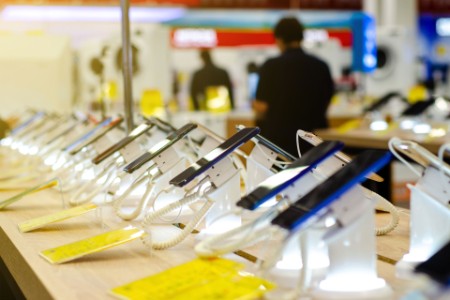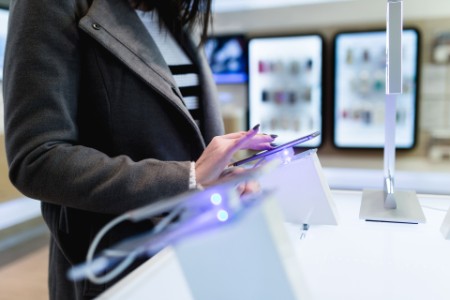
Chapter #1
Observable trends driving telecommunication retail’s evolution
From evolving store formats to shifting demographics, major change is shaping the industry’s future.
Various trends are accelerating the necessary evolution of the telecom retail industry, and they all focus on the same thing: the customer. A telecom retailer’s future will depend in part on its ability to transform the customer experience quickly enough. The following observable trends are driving this need.
Online channels are preferred, but physical stores are still required
A 2022 survey² found that online purchases are the preferred route for customers because using that channel is easier, but some consumers still have doubt and anxiety while purchasing devices online without human interaction.

Source: “What channel(s) would you prefer to use while making a purchase from a communications service provider?,” Consumer Sentiment on Communications, Salesforce, 2022.
Shoppers are using multiple channels to make purchases
One study reports that 73% of shoppers rely on multiple channels during their purchasing journey.³ For instance, a typical customer may engage with a brand through several touch points, such as conducting a web search, browsing the brand’s website, making a phone inquiry or turning to social media channels. The journey may culminate in a visit to the physical store or an online purchase.
These findings underscore the crucial need for today’s markets to invest in developing a seamless omnichannel experience. By optimizing their omnichannel strategy, companies can create an interconnected journey for customers, boosting trust and brand loyalty.

Source: Consumer Sentiment on Communications, Salesforce, 2022.
Nontraditional formats are giving the in-store customer experience a new look
The pandemic brought about a dramatic shift in consumer behavior, with a significant decline in traditional in-person store visits observed. According to a 2021 study on telecom retail opportunities, these visits have decreased by 20% post-pandemic, while alternative purchasing methods such as “buy online, pick up in store” (BOPIS) have seen a sharp uptick.⁴ BOPIS has been around for several years, and as customers become more and more comfortable with technology, we continue to see them generally limiting the amount of time they spend in stores.
Compelling survey data published by Doddle supports this trend, revealing that a staggering 85% of shoppers surveyed made additional in-store purchases while picking up their online orders.⁵ These findings highlight the immense potential for retailers to create a frictionless omnichannel experience that seamlessly integrates physical and online shopping. By offering BOPIS and similar services, retailers can engage customers, build loyalty and drive revenue growth.
The consumer of the future is here
Gen Z, the first generation of true digital natives, will have global spending power of US$33 trillion by 2026 and is poised to surpass millennials in terms of income by 2031, according to Bank of America.⁶ Gen Z consumers grew up with technology and expect personalized, connected experiences across the buying journey, from research to advocacy. Despite being digital natives, Gen Z still values shopping in stores, with a study by Euclid Analytics finding that 81% of Gen Z customers prefer to shop in store for items such as electronics.⁷ To attract Gen Z into the retail environment, retailers should consider designing experiences that reflect this important demographic’s values and priorities, such as community, sustainability, affordability and excellent personalized customer service.

Source: Physical phone stores are still the primary driver of telecom brand perception and customer experience, NCR Corporation, 2021.

Chapter #2
How the nature of in-person retail store visits is changing
The overall in-store telecom customer experience is about to look much different.
In these advanced markets, customers still frequent physical stores (albeit with different formats), but the reasons for their visits have evolved — and will continue to evolve. Retailers in these markets must adapt to this evolution to safeguard their growth in the future. Below are three in-store experiences that are likely to evolve further.

Chapter #3
Crucial areas of focus for telecommunications retailers
To future-proof retail stores, telecom companies must prioritize elements like data and technology.
To stay competitive in the evolving retail landscape, telecom providers will need to focus on key areas and make strategic investments so they can deliver a seamless and differentiated customer experience. Here are some areas companies can prioritize to adapt and thrive in the changing retail landscape.
- Seamless integration between physical and digital channels – With the continued growth of online shopping, telecommunications retail stores may become more focused on fully integrating in-person experiences with digital channels. This could involve the use of AR and other immersive technologies to create engaging and interactive experiences that blend the physical and digital worlds.
- Personalized, data-driven experiences – Telecommunications retail stores may increasingly rely on customer data to provide personalized experiences tailored to individual needs and preferences. However, they must do so while following regulations and laws.
- Automation and self-service – Telecommunications retail stores may become more automated, with self-service kiosks and digital assistants handling routine tasks, such as providing product information and facilitating purchasing. This could free up staff to focus on higher-value interactions with customers, such as personalized consultations or technical support. Additionally, predictive maintenance tools and capabilities, such as alerting customers of data usage information or upcoming upgrade opportunities, can proactively get customers in stores and help shops anticipate the demand for staff.
- Transforming retail spaces – Telecom retailers will need to adapt to the changing retail landscape by offering more engaging and interactive in-store experiences, providing additional services and support, and leveraging digital channels to enhance the customer experience. They may also need to consider reimagining store types, including full-service stores, experiential showrooms, express stores and kiosks.
- AR and VR – Telecommunications retailers can leverage AR and VR technologies to offer immersive and engaging in-store experiences, such as virtual product demonstrations or interactive games. This can help them attract and retain customers while also providing a differentiated experience that is difficult to replicate online.
Summary
Technology will be a major influence on the future of telecommunications retail as telecom companies integrate omnichannel capabilities, AI and self-service tools into their retail stores. Additionally, experiential and interactive stores will become increasingly important as telcos look to create engaging, memorable in-store customer experiences. The shift toward online capabilities and digital transactions will continue, fueled by growing consumer comfort with online transactions and supported by the increasing availability of online trade-in tools and platforms. Nevertheless, telecom companies that adapt and proactively evolve their offerings are likely to differentiate themselves and retain their customers’ loyalty in an increasingly competitive landscape.


